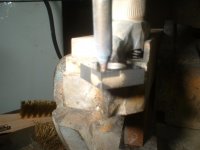Depending on how accurately you need to position the pads, you can do a few different things. If the wear pads fit into a pocket or other feature and can sit as they may, i’ve many times heated up the steel substrate without anything on it at all. Not the items to be brazed, no flux, nothing. A really generous pre-heat on a thick steel table to get the substrate close to brazing temp, then slap the pad(s) on, flux it with powder, put a steel block on top of the pad to block part of it in, then heat up the pad and rest of the block together and fill er up.
If you need more accuracy during fixturing, you can use a destaco or kant twist that is considerably larger (for clearance) than the parts, and replace the wear blocks/clamping post with solid stainless blocks or a thick post.
If you need pretty close tolerances, drill the block and the pad for a dowel pin. Ensure the pin is below the surface of the pad, and that space then becomes your weep hole.
You might also consider brazing preforms or flat “silver shim sheet” which can be placed wherever you want prior to striking the torch.
If you’re going to preheat seaprately, use powdered flux and not liquid, or else the water present in the liquid flux will vaporize upon contact to the pre-heated block and make the torch operation fairly difficult.


